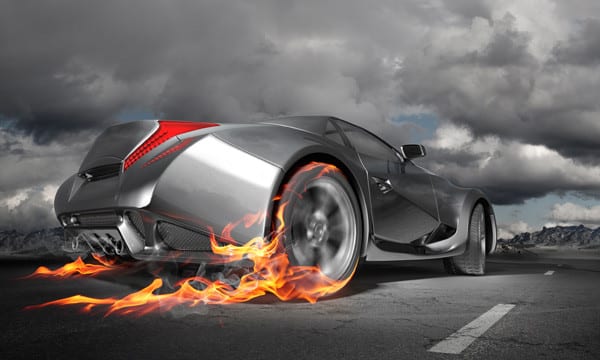 When I studied with Bobby Ore, (stunt driver extraordinaire and instructor to stunt drivers), the first thing he focused on was not how to slam the car into a power slide… Nor did he jump into using the e-brake to lock up the tires and get a skid going that you could then use to flip a 180 degree turn. Here’s a video of him chasing me down the test course:
When I studied with Bobby Ore, (stunt driver extraordinaire and instructor to stunt drivers), the first thing he focused on was not how to slam the car into a power slide… Nor did he jump into using the e-brake to lock up the tires and get a skid going that you could then use to flip a 180 degree turn. Here’s a video of him chasing me down the test course:
The most important thing that he laid down as law was actually HOW TO STEER.
Sounds sort of silly, but it’s true. Precision drivers (and off-road drivers) use a technique that most people find foreign… A technique called shuffle steering.
This is NOT the steering technique you and I were raised with, and it seems somewhat counter-intuitive at first. To understand why shuffle steering works, it’s helpful to first understand why the way we normally steer DOESN’T work (as well as it could).
So let’s take a step back and look at how the “10 and 2” hand position evolved…
Back before there were cars, roads were trafficked primarily by horses and wagons. Oh… and LOSERS walking like chumps.
So the very first cars had large wheels similar to wagons… As a result, roads, (which were mostly unpaved), had large ruts or deep grooves.
Because of this, drivers had to pull hard on the steering wheel with both hands to get the car “out of a rut”. For additional leverage, the steering wheels were also quite huge. From this early need evolved the position of holding ones hands at 10 and 2 o’clock… giving a driver the most leverage to pull down with their body weight on the wheel. (And at the same time, the evolution of the phrase, ‘stuck in a rut’).
Times have obviously changed. You’d be hard pressed to find a street vehicle that doesn’t have power steering, and most of us drive on highly civilized paved roads. We also travel (and have accidents) at high speeds, and have these handy airbags that explode from the middle of our steering wheels… More on that later.
When I trained with Bobby Ore, the stunt driver who instructs stunt drivers, he explained that, while this hand position makes perfect sense if you’re trying to drive a Model A Ford and steer it out of ruts, it doesn’t make any sense for a modern car on a paved road with power steering.
“But race car drivers use this hand position!” I can hear you shout. To which I say “stop shouting!”
You see, race cars are nothing like the cars that you and I drive on city streets. A Formula 1 car, for example, is 1/2 turn from lock to lock… that means that to turn fully left, it’s only 1/4 turn of the wheel… and to turn fully right, it’s only a 1/4 turn of the wheel to the right. Race cars have extremely tight steering, and this is also why they can’t pull u-turns… They just aren’t made for the kind of maneuvers street vehicles are made for.
By contrast, the cars that we drive on city streets are a full turn and a half from lock to lock… That means that to turn the wheel all the way left you must crank the wheel 270 degrees.
If you sit at your steering wheel and hold your hands at 10 and 2, and then turn your wheel to the right, you’ll notice that after you turn it about 90 degrees, you’ve got to replace your left hand with your right hand to keep turning… and since you have to turn it 270 degrees, you’ll have to replace your hands several times.
A very common injury in car crashes is for the driver to break their thumbs on the steering wheel upon impact… this results from holding the wheel with your thumbs wrapped around it… upon impact, your hands continue forward, yanking your thumbs back against the wheel, and both breaking your thumgs and/or fracturing or breaking your wrists. I’ve been told by several ER nurses that this is an extremely common injury.
Another complication from the 10 – 2 hand position is that modern cars have airbags. Airbags explode from the center of the steering wheel. If you grip the wheel in the 10 o’clock and 2 o’clock position, the airbag will slam into and possibly break or fracture your wrists. If you turn the wheel and cross your wrist(s) in front of the center of the wheel, when the airbag deploys it will not only injure your wrists, but it will slam them into your face, causing serious injuries.
I really don’t like to hear my car say “stop hitting yourself!” as I smash my nose with my wrist, so I find these compelling reasons to shift my steering technique.
All we need now is a compelling alternative… And that’s exactly what Bobby Ore teaches. He calls it “shuffle steering”, and it goes like this:
You place your right hand at the 4-o’clock position, and your left hand at the 8-o’clock position, and grasp the wheel lightly with your finger-tips. Bobby is adamant about the light, finger-tip grip. And let me tell you, if this man can spin a car 720 degrees at 90 miles an hour through a pair of cones while gripping lightly, you can navigate the local Costco parking lot this way. It’s surprising how little effort most cars require, and how much most people over-grip the wheel.
This hand position solves all the problems noted above… by holding in the lower portion of the wheel, it feels unnatural to grasp with your thumbs wrapped around the wheel, so you use the finger-tip grip and don’t break your thumbs and wrists in an accident.
Your hands also never cross each other, nor do they cross the wheel center/airbag, so your wrists are free from the spontaneous-balloon-of-death airbag impact.
As an added bonus, the new more relaxed position isn’t as draining on your arms, hands or shoulders… Sweet.
When you need to turn the wheel, you use the “shuffle”. Here’s a breakdown of how it works (It sounds much more complicated than it really is):
If you are turning right, you do the following:
With both hands holding the wheel lightly, your right and left hands should be in the 4 o’clock and 8 o’clock positions, holding with just finger tips, palms facing up. To turn right, you simply grip with your right hand at the 4-o’clock position, and pull the wheel down and to the left in a clockwise direction, while lightening your grip with your left hand, allowing the wheel to slide through your left fingers, and moving your left hand and right hand together to the 6 o’clock position. when they come together, the left hand grasps the wheel and continues the motion to the left, while the right hand returns to its starting position on the right… Both hands move away from each other, and the pattern repeats.
This results in your hands coming together and apart at the bottom of the steering wheel. The wheel slides continuously, and with a little practice you can turn it surprisingly fast.
This also results in a very smooth and even turn of the wheel, and you NEVER run out of real estate. If you lock your hands on the wheel at 10 and 2, you will not only cross your arms, but you will quickly run out of ability to keep turning the wheel without letting go and doing a big awkward re-positioning.
While I first learned this technique doing stunt-driving, I saw it again when I was off-roading with some of the top drivers in the world… The guy driving with me had won the Camel Trophy and was a professional off-road racer… And also used shuffle steering. It’s a great technique… give it a try and see!

2 Comments